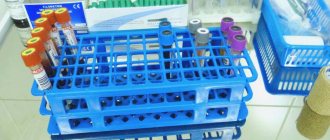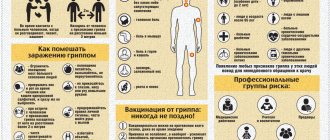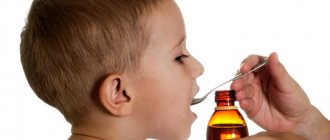Autumn and winter are the period of colds and the spread of viral infections. It is during this time that the incidence rate increases significantly. For some people, distinguishing the flu from a cold can be difficult. Although these two diseases are similar in symptoms, course and even cause, treatment for the flu and colds can be very different. And incorrectly prescribed medications can only worsen the situation.
How to distinguish the flu from a cold - we'll figure it out in this article.
How is the flu different from a cold?
- Onset of the disease . Flu symptoms develop rapidly. And it progresses quickly in the body.
The source of influenza is sick people during the incubation period or the height of the disease. The disease is transmitted by airborne droplets when sneezing, coughing, shaking hands, and also through dirty food (it has not been thermally processed enough). The infection begins to manifest itself in the period from 4 hours to 3 days. In general, the disease goes away in 5-7 days.
A cold is a disease of the body associated with hypothermia. A cold develops gradually, progressively, and painful symptoms appear within a day or two. It is usually easy to treat. But in advanced forms it can develop into other more severe diseases.
- Temperature . With the flu, there is a high body temperature, which can reach 39-40 degrees. With a cold, the temperature usually remains at the standard level.
- Weakness . People with a cold often ignore symptoms such as cough and runny nose, thinking that it will “go away on its own” with time. A cold can be carried on your feet, although it is undesirable.
But during the flu, the patient immediately realizes that he is sick; often he cannot even have the strength to get out of bed. Aches all over the body, severe headache, fever - these symptoms cannot be confused with anything else.
- Cough and runny nose . During the flu, these symptoms do not appear immediately (only after 5 days), and may not appear at all. With a cold, a debilitating cough, sore throat when swallowing and a runny nose are noted.
- Red eyes, itching and watery eyes . The picture of the flu is complemented by red eyes, severe weakness, fever, and bursting blood vessels in the nose. And in severe forms, even convulsions, vomiting, rapid heartbeat, and lack of air are possible.
When you have a cold, your eyes do not turn red or water, and if this happens, it is more likely to indicate a bacterial infection.
Sleep and proper rest
If you have caught the flu or ARVI and are going to treat yourself at home, then this condition is one of the most important. Most often, it is lack of sleep and lack of proper rest, combined with permanent stress, that causes the body to capitulate to infection.
Therefore, you need to act on the contrary - go to bed no later than 22 hours and get a good night's sleep. It is worth remembering here that it is no coincidence that bed rest is one of the first medical recommendations for infectious diseases.
An important point is that in order to ensure proper rest, you need to stop wasting time on your smartphone and computer. Give yourself a break from information. Dopamine fasting sometimes heals just as well as normal.
Why is it necessary to distinguish between these diseases?
The group of people with weakened immune systems includes pensioners and children, people with chronic diseases. This means that their immune system is most susceptible to attack by pathogens. An incorrect diagnosis can lead to deterioration in the functioning of the entire body and incorrect treatment.
Due to influenza, the natural functions of the immune system are weakened, against the background of this, other infections can join and develop. These are mainly respiratory tract infections: the lungs are affected by streptococcal or staphylococcal flora. This contributes to the development of pneumonia, pulmonary hemorrhage, and edema.
Influenza in adults can be complicated by the development of sinusitis, sinusitis, pericarditis and acute cardiovascular failure. Influenza in children is complicated by otitis media, focal pneumonia, and bronchitis.
Diagnosis of flu and colds
If you suspect a disease, you should seek help from a doctor. For adults - a therapist, for children - a pediatrician. The consultation takes place in several stages.
- Initial examination. The doctor will ask you questions about your health, review your medical history, and refer you for tests and diagnostics. After a private consultation, the therapist prescribes an ultrasound of internal organs and laboratory tests to detect viruses and infections.
- Establishing diagnosis. After collecting anamnesis, the specialist will identify the disease based on the results obtained. He will tell you about the causes of your condition, prescribe treatment with various methods and drugs, or refer you for hospitalization.
- If necessary, the therapist will refer you to a specialist for further examination.
As for the examination of the child by the pediatrician, parents must be present. This helps the doctor quickly find a common language with the patient. Initially, the pediatrician listens to the lungs, measures the child’s body temperature, and examines the throat for inflammation.
The specialist listens to parents' complaints about the child's health. After this, it is necessary to undergo an examination to diagnose the disease. The pediatrician will order a blood/urine test, as well as additional tests if necessary (scraping, x-ray, bronchoscopy). At a follow-up consultation, the specialist will make a diagnosis, prescribe medication, or refer you to a specialized specialist.
Washing and rinsing: the first line of defense
When the first symptoms appear, there is a chance to neutralize the infection or at least reduce the intensity of the disease. This will help by rinsing your nose with a solution of hydrogen peroxide and gargling with sea salt or soda. To rinse the nasal mucosa, prepare a solution at the rate of 1 teaspoon of peroxide per half glass of warm water. To gargle, add one teaspoon each of salt and soda to a glass of warm water.
This is a recommendation for adults. If a child is sick and washing and rinsing in the usual way is problematic, then you can use pharmaceutical sprays with sea water.
How are colds and flu treated?
Hospital mode
The first thing the doctor will prescribe for such a disease is bed rest. Carrying an illness on your feet is extremely dangerous for both you and those around you. The influenza virus is highly contagious. Everyone you come into contact with will also get sick. You, in turn, risk getting a bacterial complication of the flu.
It is also necessary to adhere to a certain diet: try to drink as much warm drink as possible (herbal teas, milk with honey, berry fruit drinks, water), do not eat heavy fried foods. If you or your child suffering from a disease does not want to eat, there is no need to force it. Decreased appetite is a common symptom of the disease.
Drug therapy
First of all, antiviral drugs are prescribed for influenza and colds , which inhibit the vital activity and spread of the virus inside the human body. Such medications are prescribed for severe or moderate severity of the disease. The drug is most effective in the first days of the disease.
Antipyretics are used only at very high temperatures to help the body cope with the fever and prevent complications from developing. These drugs also have an anti-inflammatory effect.
Antibiotics for colds are taken only after a doctor's prescription. When, against the background of the development of influenza, an acute bacterial infection appears that the body cannot cope with on its own. Important: if you start taking antibiotics, the course cannot be interrupted.
Antihistamines relieve the unpleasant consequences of the disease, such as redness, itching, lacrimation, swelling of the nasopharynx and nasal discharge.
Immunostimulants help strengthen the body's defenses and help the immune system independently repel attacks from viruses and bacteria.
Drops for a runny nose relieve swelling of the mucous membrane, allow the nose to breathe normally and prevent the occurrence of microbial complications. However, the drug should not be taken for more than 5 days, because there is a risk of chronic swelling of the mucous membrane.
Nonspecific prevention
To prevent influenza and ARVI, two types of pharmacological drugs have been developed:
• Direct acting drugs. They block enzymes on the surface of the virus. Because of this, the infectious agent loses the ability to reproduce its RNA and proteins. • Agents that stimulate the production of protective interferons to increase the body's resistance to infections.
Antiviral medications are available in the form of tablets, capsules, and powders. For children, there are syrups, suspensions, and drops that are convenient to take.
The TOP 5 drugs include:
• Arbidol. Active against most pathogens of acute respiratory viral infections, including influenza viruses. For prevention, take twice a week, for treatment - 4 times a day. In powder form it is allowed for children from 2 years old, in tablet form - from 6 years old. • Ergoferon. A fast-acting immunomodulator with proven effectiveness against respiratory viruses. Tablets for sublingual administration are prescribed: 5 pcs per day. within 2 hours, on subsequent days - 1 pc. three times. • Ingavirin. An innovative antiviral agent with high anti-inflammatory activity. Used for all types of acute respiratory viral infections, including coronavirus infection. In pediatrics it is used from 7 years of age. To achieve results, 1 capsule per day is enough. • Kagocel. A powerful immunostimulant, it causes the synthesis of interferons by all cells of the body that participate in the antiviral response. Allowed for children from 3 years old. Prevention is carried out in cycles: 2 days, 2 tablets - 5 days break - 2 days, 2 tablets. • Anaferon. Increases the production of interferon, prescribed for the prevention and treatment of acute respiratory viral infections. In pediatrics, a specially developed children's version of the drug is used.
Unlike antibiotics, antivirals are sold without a doctor's prescription.
Organization of home prevention of ARVI and influenza includes:
• Nutrition correction. Foods high in ascorbic acid—vegetables, wild berries, fruits, herbs—help stimulate the formation of interferon. Protein is the building material for immune cells, so the diet should contain a sufficient amount of meat, fish, dairy products, and cereals (millet, oats, buckwheat). The main helper of immunity is vitamin D. It is found in egg yolk, seaweed, and cod liver. • Hardening, physical activity. It is recommended to start hardening procedures in the summer - before the start of seasonal epidemics. Sports activities saturate the blood with oxygen, accelerate hemodynamics, and increase blood supply to organs. This allows you to maintain the functionality of immune system cells to produce interferons.
• Use of folk remedies. Products with antimicrobial effects (garlic, ginger, onions), as well as plants with immunostimulating properties (ginseng root, rose hips, echinacea, sage, lemon balm) help protect against seasonal diseases.
To prevent illness, it is important to adhere to a rational work and rest regime. Doctors recommend getting enough sleep, walking daily, avoiding conflict situations that lead to stress, and taking vitamin and mineral supplements.
Prevention of flu and colds
The most reliable way to prevent influenza is vaccination. The flu shot is effective, but does not provide long-term immune protection, so vaccination should be done annually. Regular flu vaccination increases the production of antibodies to the virus.
The vaccine has no side effects, and the improved composition protects against mutated strains of the virus. Timely vaccination prevents infection. Even if infected, the disease will be mild.
After getting a flu shot, your temperature may rise to 37.5℃, you may experience chills, sweating, a general feeling of weakness and poor appetite. Redness, slight swelling, itching and pain may be observed at the injection site. This is an indication that your body is developing immunity to the flu. After vaccination, it is strictly forbidden to visit a bathhouse/sauna, swim in open water, engage in tiring physical activity, or drink alcohol.
Is the flu contagious?
Flu is highly contagious. People can spread it the day before they feel sick and continue to spread it until all symptoms disappear. This is approximately 1 week for adults, but for small children the period may be longer. Influenza usually occurs in the form of annual epidemics. An epidemic is when a disease spreads quickly and affects many people in one area at the same time. Some years the epidemic becomes more severe and widespread than other years. An epidemic that spreads throughout the world is called a pandemic. This is much less common. There have been three influenza pandemics in the 20th century, and so far only one in the 21st century, the 2009 influenza A (H1N1) pandemic.
During a pandemic, wearing masks can help protect the community from the spread of viruses. All children aged 2 years and older are advised to wear masks when they are in public or around people who do not live with them and have signs of infection. Masks can help stop the spread of the flu.
Contraindications to the flu vaccine
- at least 6 months have not passed since the last vaccination;
- bronchial asthma;
- allergic reactions;
- iron deficiency;
- diseases of the respiratory system in acute or chronic form;
- allergic reaction to chicken protein;
- heart failure;
- endocrine diseases;
- blood pathologies;
- first trimester of pregnancy;
- severe renal failure;
- period of exacerbation of chronic diseases.
To prevent flu and colds, follow a few simple rules:
- Strengthen your immune system. Exercise more often or give your body light exercise. Take a walk in the fresh air, this will saturate your lungs with oxygen.
- Avoid hypothermia. This occurs due to a sharp temperature change and the action of the air conditioner.
- Use antibacterial agents, especially during cold season.
- Eat a balanced diet. This will provide the body with the necessary microelements.
Stop list: what not to do in case of viral diseases
Drink alcohol and wipe yourself with alcohol. Viral diseases are already accompanied by general intoxication of the body. If you add alcohol intoxication to it, you will not speed up, but slow down recovery.
Reduce the temperature whenever it rises. An increase in temperature is one of the measures by which the immune system fights infection. Antipyretic drugs should only be used at temperatures of +38°C and above.
Avoid swimming and showering. During treatment, toxins are released through the skin through sweat, so you need to shower even more often than usual. The only exception is that at elevated temperatures it is better to use warm rather than hot water for washing and avoid hypothermia after a bath.
Do not ventilate the room for fear of drafts . The motto “sun, air and water are our best friends” is relevant not only for the healthy, but also for the sick. In case of viral diseases, it is especially important to maintain an optimal level of humidity in the house (40-60%) and ensure constant access to fresh air.
This point is so important that it is worth talking about separately.
Where to get diagnosed and treated for flu and colds in Krasnoyarsk?
This can be done at the Medunion private medical clinic.
Is a child or an elderly person sick? Then do not wait to see a doctor, but simply call a specialist at home. It's not only fast, but also very convenient! The specialist will examine the patient in a familiar environment, prescribe tests, and prescribe the necessary treatment. And the nurse will take samples or vaccinate you.
Sign up for a medical appointment and take care of the health of your loved ones. You can do this in any way convenient for you - online or by phone on the website. The cost of an initial consultation with a doctor starts from 1100 rubles.










